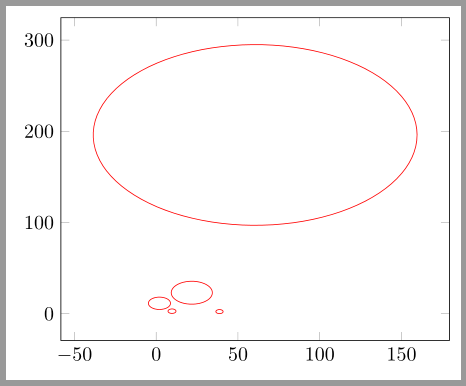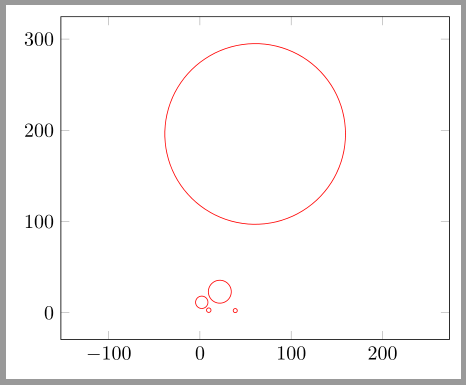|
Hallo liebe LaTeX-Freunde, ich würde gerne Koordinaten (2 \begin{filecontents*}{dumm.dat} 1.0 2.4 2.2 1.2 3.3 3.4 4.4 1.1 5.5 9.9 \end{filecontents*} \newcommand\plotF[2]{%Plotte Kreis \addplot[samples=100, domain=0:360, red]({(1+#2*#2)*cos(x)+2*#1*#1}, {(1+#2*#2)*sin(x)+2*#2*#2}); } \documentclass[margin=2mm]{standalone} \usepackage{pgfplots} \begin{document} \begin{tikzpicture} \begin{axis}[clip=false] %Hier sollten zeilenweise die Koordinaten aus dumm.dat eingelesen werden und das Makro \plotF{x1}{x2} ausgeführt werden \end{axis} \end{tikzpicture} \end{document} |
|
Eine Möglichkeit ist wieder das Paket \begin{filecontents*}{dumm.dat} 1.0 2.4 2.2 1.2 3.3 3.4 4.4 1.1 5.5 9.9 \end{filecontents*} \documentclass[margin=2mm]{standalone} \usepackage{pgfplots} \pgfplotsset{compat=1.12} \usepackage{datatool} \DTLsetseparator{ }% Leerzeichen als Spaltentrenner \DTLloaddb[noheader]{mylist}{dumm.dat} \newcommand\plotF[2]{% plotte Kreis \addplot[samples=100, domain=0:360, red] ({(1+#2*#2)*cos(x)+2*#1*#1}, {(1+#2*#2)*sin(x)+2*#2*#2}); } \newcommand\argI{} \newcommand\argII{} \begin{document} \begin{tikzpicture} \begin{axis} \DTLforeach{mylist}{\argI=\dtldefaultkey1,\argII=\dtldefaultkey2}{ \plotF{\argI}{\argII} } \end{axis} \end{tikzpicture} \end{document}
Wenn das dann tatsächlich Kreise werden sollen, musst Du noch mit der Option \begin{filecontents*}{dumm.dat} 1.0 2.4 2.2 1.2 3.3 3.4 4.4 1.1 5.5 9.9 \end{filecontents*} \documentclass[margin=2mm]{standalone} \usepackage{pgfplots} \pgfplotsset{compat=1.12} \usepackage{datatool} \DTLsetseparator{ }% Leerzeichen als Spaltentrenner \DTLloaddb[noheader]{mylist}{dumm.dat} \newcommand\plotF[2]{% plotte Kreis \addplot[samples=100, domain=0:360, red] ({(1+#2*#2)*cos(x)+2*#1*#1}, {(1+#2*#2)*sin(x)+2*#2*#2}); } \newcommand\argI{} \newcommand\argII{} \begin{document} \begin{tikzpicture} \begin{axis}[axis equal] \DTLforeach{mylist}{\argI=\dtldefaultkey1,\argII=\dtldefaultkey2}{ \plotF{\argI}{\argII} } \end{axis} \end{tikzpicture} \end{document}
Super! Dank Dir! Schön, dass einem hier immer so professionell geholfen wird!
(23 Mai '15, 20:32)
Ross
|


